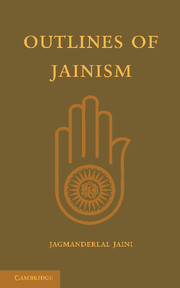Book contents
- Frontmatter
- DEDICATED
- TABLE OF CONTENTS
- PRELIMINARY NOTE
- PREFACE
- BIBLIOGRAPHICAL NOTE
- INTRODUCTION AND HISTORY
- OUTLINES
- TEXTS
- APPENDICES
- APPENDIX I Jain Logic
- APPENDIX II Cosmogony, Cosmology, Astronomy
- APPENDIX III Sixty-three Great Persons, etc.
- APPENDIX IV 143 Qualities, etc., of Saintly Souls
- APPENDIX V The Ancient Jaina Sacred Literature
- INDEX
APPENDIX V - The Ancient Jaina Sacred Literature
from APPENDICES
Published online by Cambridge University Press: 05 June 2016
- Frontmatter
- DEDICATED
- TABLE OF CONTENTS
- PRELIMINARY NOTE
- PREFACE
- BIBLIOGRAPHICAL NOTE
- INTRODUCTION AND HISTORY
- OUTLINES
- TEXTS
- APPENDICES
- APPENDIX I Jain Logic
- APPENDIX II Cosmogony, Cosmology, Astronomy
- APPENDIX III Sixty-three Great Persons, etc.
- APPENDIX IV 143 Qualities, etc., of Saintly Souls
- APPENDIX V The Ancient Jaina Sacred Literature
- INDEX
Summary
The knowledge of Sruti (Sruta-jnana) may be of things which are contained in the Angas (sacred books of the Jainas) or of things outside the Angas. There are 64 simple letters of the alphabet. Of these 33 are consonants, 27 vowels, and 4 auxiliary (which help in the formation of compound letters). The total number of possible combinations of these 64 simple letters into compounds of 2, 3, 4, or more up to 64 letters, is 18,446,744,073,709,551,615. These are the letters (simple and compound) of Sruti in its entirety. This number being divided by 16,348,307,888, which is the number of letters employed in the central portion (madhyama-pada) of the Paramagama, gives us the number of padas of the Angas as 11,283,580,005. The remainder 80,108,175 gives us the letters of that part of Sruti which is not contained in the Angas. This part is divided into 14 Prakirnakas, such as the Dasa-vaikdlika, Uttarddhyayana, etc.
I. THE TWELVE AṄGAS
The Angas are twelve, as follows :—
1. The Achara-anga comprises a full exposition of the rules of conduct for ascetics. It contains 18,000 padas (words).
2. The Sūtrakrita-anga comprises a detailed exposition of knowledge, humility, etc.; of religious rites and difference between the rites of one's own religion and those of the religions of others. It contains 36,000 padas.
3. The Sthāna-anga comprises an exposition of one or more sthanas, or points of view in considering jiva (soul), pudgala (matter), and other dravyas. While the jiva-dravya, or soul, is from the point of view of consciousness the same everywhere ; from the point of view of being liberated (siddha) or mundane (samsarin) it is of two kinds. Similarly, the sairisarin, or mundane jiva, that is, the soul not yet perfectly freed from the bondage of Icarmas, which keep it moving in the cycle of existences, is of three kinds, stationary (sthdvara), deficient in the organs of the senses (vikalendriya), and in possession of all the organs of the senses (sakalendriya). The liberated souls, too, are of many kinds from the point of view of place, time, etc. This Anga contains 42,000 padas.
- Type
- Chapter
- Information
- Outlines of Jainism , pp. 135 - 146Publisher: Cambridge University PressPrint publication year: 2013



